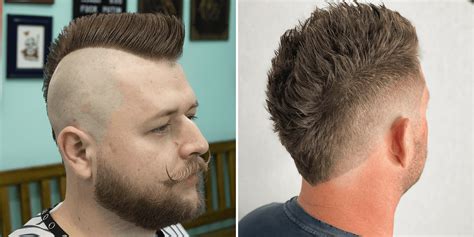Introduction

In the realm of hairstyles, two rebellious and eye-catching styles stand out: the faux hawk and the mohawk. While they share a similar edgy aesthetic, these two hairstyles have distinct characteristics that set them apart. In this comprehensive guide, we delve into the nuances of both styles, exploring their history, techniques, variations, and the factors to consider when choosing between them.
Faux Hawk
Definition
A faux hawk is a hairstyle that mimics the appearance of a mohawk without shaving the sides or back of the head. It features hair brushed upwards from the forehead to the crown of the head, creating a raised, spiky effect. The hair on the sides and back is typically left shorter and blended into the raised section.
History
The faux hawk is said to have originated in the late 1980s and early 1990s within the skateboarding and punk rock subcultures. It gained popularity among male celebrities in the 2000s and has since become a mainstay in mainstream hairstyling.
Techniques
Creating a faux hawk requires a combination of volume and texture. Hairspray or mousse is applied to the roots to provide lift, and a blow dryer and brush are used to create the desired height. The hair is then brushed back and up from the forehead to the crown, forming a triangle shape. The sides and back of the hair are trimmed and tapered to create a blended effect.
Mohawk
Definition
A mohawk is a hairstyle characterized by a raised strip of hair running from the forehead to the nape of the neck. The sides of the head are shaved or trimmed close to the scalp, creating a dramatic contrast with the raised section.
History
The mohawk has a long and diverse history, with origins in various cultures worldwide. In ancient Celtic and Germanic tribes, it was associated with warriors and represented strength and courage. In the 1970s, the mohawk was adopted by the punk subculture as a symbol of rebellion and nonconformity.
Techniques
Creating a mohawk involves shaving or trimming the sides and back of the head while leaving a strip of hair on top. This strip is then styled with gel or pomade to create a raised, hardened effect. Hair clippers or a razor are used to achieve a clean and defined shave on the sides.
Variations
Faux Hawk:
- Classic Faux Hawk: The traditional faux hawk with a raised strip of hair and blended sides.
- Messy Faux Hawk: A more casual variation with a more textured and relaxed look.
- Swept-Back Faux Hawk: A variation with the raised hair brushed back towards the crown.
- Side-Swept Faux Hawk: A faux hawk with the raised hair swept to one side, creating a more asymmetrical look.
Mohawk:
- Classic Mohawk: The traditional mohawk with a single, raised strip of hair.
- Double Mohawk: A variation with two raised strips of hair on either side of the head.
- Inverted Mohawk: A mohawk with a shaved strip on top and longer hair on the sides.
- Liberty Spikes: A mohawk with short, spiked sections of hair instead of a raised strip.
Pros and Cons
Faux Hawk:
Pros:
* Versatile and can be adapted to different face shapes and hair types.
* Easier to maintain than a mohawk.
* Can be worn in both formal and informal settings.
Cons:
* May require regular brushing and styling to maintain its shape.
* Not as dramatic as a mohawk.
Mohawk:
Pros:
* Creates a strong and rebellious statement.
* Extremely versatile with various variations.
* Can be a symbol of cultural or personal identity.
Cons:
* Requires regular maintenance and trimming.
* Can be difficult to incorporate into conservative environments.
* May require more time and effort to style.
Factors to Consider When Choosing
When deciding between a faux hawk and a mohawk, consider the following factors:
- Face Shape: A faux hawk is more flattering for oval, square, and diamond-shaped faces. A mohawk is more suitable for round and heart-shaped faces.
- Hair Type: A faux hawk is best suited for thicker hair that can hold its shape. A mohawk can work on most hair types, but thinner hair may require additional products or techniques to create the desired height.
- Lifestyle: A faux hawk is more versatile and can be worn in a wider range of settings. A mohawk may be more appropriate for individuals who are comfortable with a bolder and more unconventional style.
- Personal Preference: Ultimately, the best choice between a faux hawk and a mohawk depends on individual preferences and lifestyle considerations.
Conclusion
The faux hawk and the mohawk are both edgy and eye-catching hairstyles that offer a bold and rebellious aesthetic. While they share some similarities, each style has its own unique characteristics and appeals to different individuals. By understanding the history, techniques, variations, and considerations associated with both hairstyles, you can make an informed decision about which one best suits your style, personality, and lifestyle. Whether you opt for the versatile faux hawk or the iconic mohawk, embrace the opportunity to express your individuality and make a statement with your hair.
